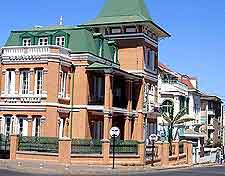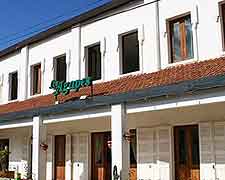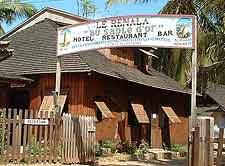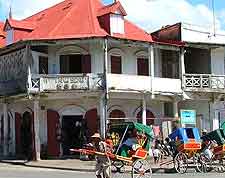Madagascar Restaurants and Dining
(Madagascar, MG, Africa)

Dining in Madagascar's restaurants can vary from being a very local experience to a rather international one. As in most other African countries, the influence of other cuisines, including those from
France,
India and the Far East, can be clearly seen. Food portions tend to be generous, whilst ambience and surroundings vary considerably from one restaurant to another.
Lunch is generally served from 12:00 to 14:00, while evening meals are served between 19:30 and 22:00. Worth noting, many restaurants are closed on Sunday.

What to Eat
Malagasy cuisine tends to be simple and rather frugal. It often features peppers and always includes rice. In fact, Madagascar holds a culinary record for consuming the most rice of any country in the world. Rice comes in many different forms. For breakfast and supper, it takes on a 'broth' consistency and is usually served with meat or omelette. However, for lunch, rice is generally steamed and served dry from the pot.
Unlike cuisine from other African countries, Malagasy cuisine doesn't use much in the way of root vegetables. When cassava is served, you are as likely to be faced with pureed leaves as the tuber itself. 'Ravitoto', considered to be Madagascar's national dish, is made of ground leaves cooked with pork.

Running a close second in terms of dining popularity, 'romazava' is also a traditional Malagasy dish. Whilst its exact makeup can vary depending on where it has been made, romazava generally consists of a selection of leaves (known as anana), which are then served with pieces of beef and pork that have been fried in oil. Seafood dishes include drakaka, commonly known as the 'big crab'.
Dessert dishes and cakes are often flavoured with locally grown vanilla. 'Mofo gasy' is a particularly popular type of sweet bread that is frequently served as a snack food.
Where to Eat
Eating out in Antananarivo is a relatively simple affair, with many restaurants offering decent food at reasonably low prices. The city's Avenue de Independence is the location of several European-style eateries, including La Brasserie and O Poivre Vert, both of which are based at the Hotel de France.

In recent years, Antananarivo's restaurant scene has expanded somewhat, with several newcomers. If you prefer to spend more and be a little bit adventurous with your choice of cuisine, Ku dé Ta in Isoraka offers traditional meals with a French flavour. For that extra-special meal, though, it is worth pushing the boat out at the Hotel Colbert's restaurant on the Rue Prince Ratsimamanga, reputed to be Madagascar's most expensive dining venue.
Away from Antananarivo and Madagascar's other large towns and cities, restaurants are far more limited. Often, it may be case of having just one restaurant and one dining menu to choose from.
Seaside towns, such as Tolanaro (Fort Dauphin) and Toamasina, are great for eating out with a view. Waterfront venues, such as the upmarket La Terrace Restaurant in Tolanaro, allow you to enjoy haute cuisine whilst watching the sunset over the Baie Dauphine.
Madagascar has lots of opportunities to stop off for a traditional snack, whether at a roadside rest stop, street stall or town kiosk. Food on offer usually includes a variety of sweet fried cakes and fritters, as well as samosas and kebabs. European-style cafe dining is also popular with visitors. Madagascar's many French patisseries serve up a rich diet of pastries, croissants and crusty bread - perfect for a picnic.
 Dining in Madagascar's restaurants can vary from being a very local experience to a rather international one. As in most other African countries, the influence of other cuisines, including those from France, India and the Far East, can be clearly seen. Food portions tend to be generous, whilst ambience and surroundings vary considerably from one restaurant to another.
Dining in Madagascar's restaurants can vary from being a very local experience to a rather international one. As in most other African countries, the influence of other cuisines, including those from France, India and the Far East, can be clearly seen. Food portions tend to be generous, whilst ambience and surroundings vary considerably from one restaurant to another.
 Running a close second in terms of dining popularity, 'romazava' is also a traditional Malagasy dish. Whilst its exact makeup can vary depending on where it has been made, romazava generally consists of a selection of leaves (known as anana), which are then served with pieces of beef and pork that have been fried in oil. Seafood dishes include drakaka, commonly known as the 'big crab'.
Running a close second in terms of dining popularity, 'romazava' is also a traditional Malagasy dish. Whilst its exact makeup can vary depending on where it has been made, romazava generally consists of a selection of leaves (known as anana), which are then served with pieces of beef and pork that have been fried in oil. Seafood dishes include drakaka, commonly known as the 'big crab'. In recent years, Antananarivo's restaurant scene has expanded somewhat, with several newcomers. If you prefer to spend more and be a little bit adventurous with your choice of cuisine, Ku dé Ta in Isoraka offers traditional meals with a French flavour. For that extra-special meal, though, it is worth pushing the boat out at the Hotel Colbert's restaurant on the Rue Prince Ratsimamanga, reputed to be Madagascar's most expensive dining venue.
In recent years, Antananarivo's restaurant scene has expanded somewhat, with several newcomers. If you prefer to spend more and be a little bit adventurous with your choice of cuisine, Ku dé Ta in Isoraka offers traditional meals with a French flavour. For that extra-special meal, though, it is worth pushing the boat out at the Hotel Colbert's restaurant on the Rue Prince Ratsimamanga, reputed to be Madagascar's most expensive dining venue.